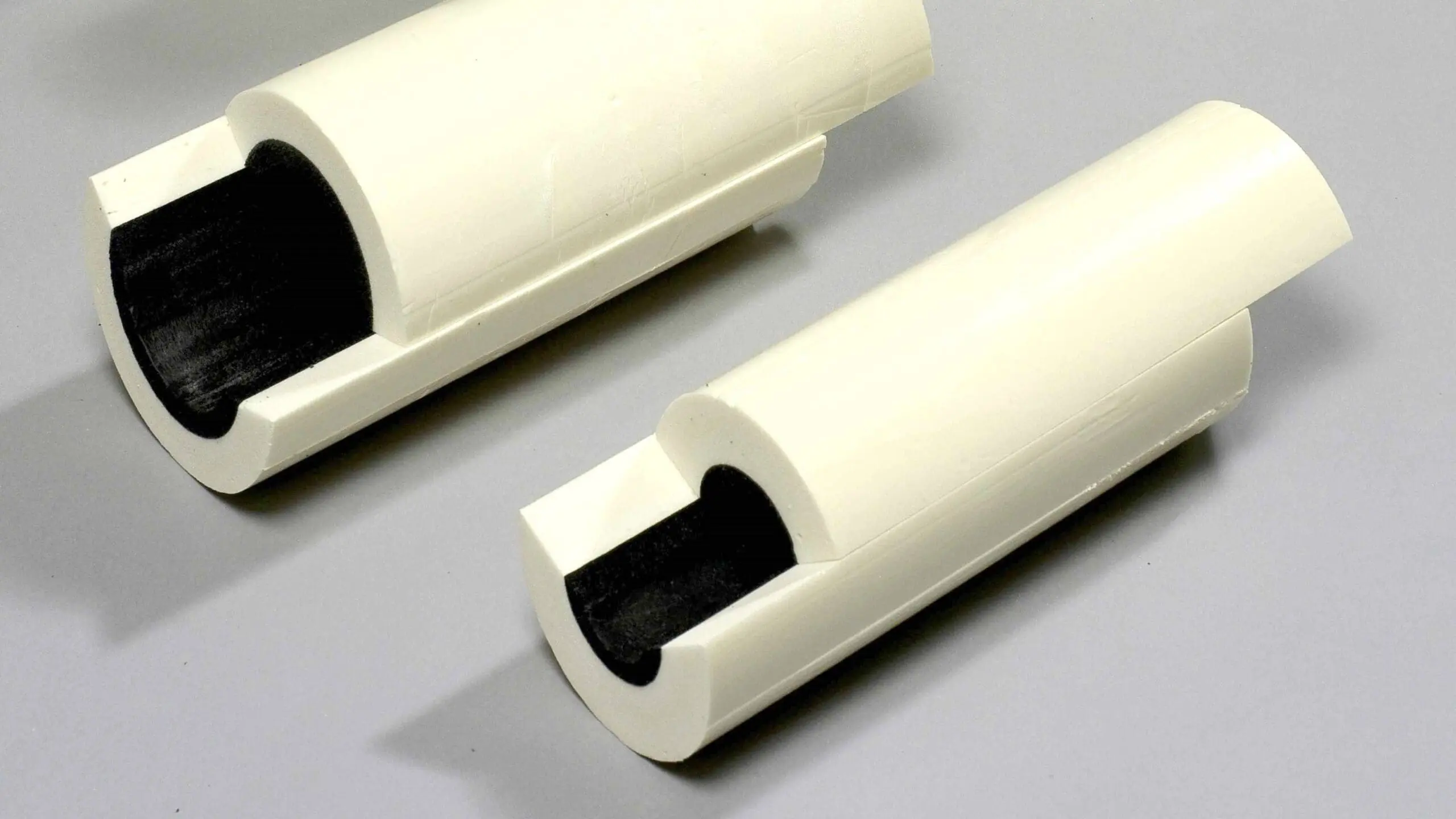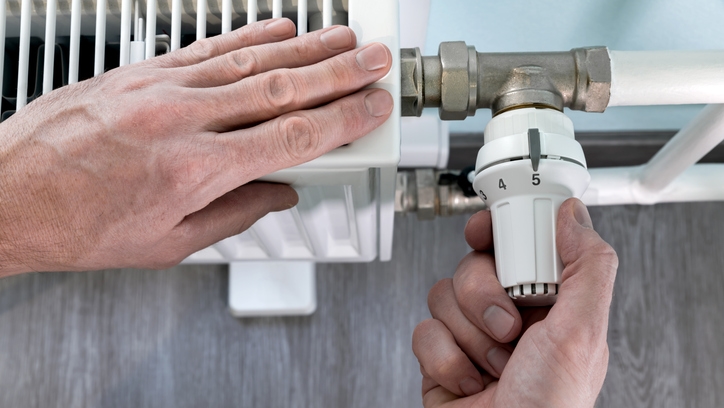What is polyurethane (PUR/PIR) insulation?
Polyurethane insulation, also known as polyurethane, and colloquially called PUR, is produced by mixing two liquids, polyol and isocyanate. The carefully calculated reaction process that starts when the two liquids are mixed is called foaming. The result of the process is a viscous, foaming molding compound that quickly forms PUR in solid form. PUR can be produced with different stiffness and density.
Dan-iso offers insulation solutions based on polyurethane in the form of molded insulation shells and custom-made applications milled out of foam blocks with our 5-axis CNC.
PIR block foam (polyisocyanurate) is a modified PUR system. PIR Block foam is distinguished by its relatively low flammability and by its resistance to higher temperatures. Dan-iso PIR block foam meets the "Euroclass E" fire test (EN-ISO 11925-2).
Casting of pipe bowls
When the liquids are injected into special molds, pipe cups can be cast. Dan-iso's main product is insulating cups for pipe joints in the district heating sector and the industrial sector. In addition to ordinary pipe cups, Dan-iso can supply pipe cups in varying shapes and of different types, e.g. cups with mineral wool or flexible foam inserts or cups with an outer covering of e.g. foil or nappa.
The expertise lies in knowing all the variation possibilities, in order to get the best out of the material. Dan-iso has more than 30 years of experience to build on when it comes to casting pipe shells.
Rigid PUR is one of the most effective insulation materials available. The insulation value is over 30 % better than stone wool, mineral wool and EPS insulation.
What is PUR pipe insulation used for?
How is PUR and PIR Pipe Insulation Made?
Dan-iso offers technical insulation based on polyurethane in the form of pipe shells and custom-made parts. The pipe shells are used to insulate pipes and prevent heat loss. Our custom-made solutions are created using CNC technology, which makes it possible to produce precise and customized insulation materials from large PUR and PIR foam blocks. This technology ensures high precision and effective solutions for technical insulation.
PIR (polyisocyanurate) is a modified version of PUR, where the chemical composition of the material has been changed to improve certain properties. PIR pipe insulation differs from PUR by having a lower flammability and a higher resistance to heat. This makes PIR a better choice in situations where fire resistance and temperature control are required. PUR and PIR pipe insulation are both used in technical insulation, but PIR is more often chosen for applications where fire resistance is an important requirement.
The insulation properties of PUR and PIR
Both PUR and PIR are known for their excellent thermal insulation properties. They have low thermal conductivity, which means they effectively retain heat inside systems and prevent heat loss. This makes them ideal for use in both construction and industry, where it is important to maintain a stable temperature in pipelines, HVAC systems and other heat-sensitive applications. In addition, both PUR and PIR have high mechanical strength, making them resistant to physical stress.
PIR pipe insulation is known for its improved fire resistance compared to PUR. This makes it a popular choice in situations where fire safety is a priority, such as in buildings and industrial installations. PIR meets more stringent fire test requirements and often achieves the fire classification “Euroclass E”, which means it has a lower flammability and reduces the risk of fire spreading. This is an important property in areas where the insulation needs to protect against high temperatures and fire hazards.
Areas of application and benefits of PUR and PIR pipe insulation
PUR and PIR pipe insulation is used in a wide range of technical and industrial applications. Both materials are used for pipe insulation in construction and industrial production, where it is necessary to prevent heat loss and ensure efficient energy use. PUR and PIR pipe shells are also commonly used in HVAC systems, heating installations and pipelines transporting hot or cold fluids. They help to maintain the desired temperature constant, minimizing energy consumption.
In industrial applications, it is crucial to choose insulation materials that are both efficient and durable. PUR and PIR pipe insulation offer a good balance between thermal efficiency and mechanical strength, making them ideal for withstanding the demands of industrial environments. Both materials contribute to maintaining a stable climate, reducing energy consumption and minimizing operating costs in industrial facilities, making them an effective choice for long-term solutions.


Advantages of polyurethane insulation
Effective insulation and durability
PUR (polyurethane foam) has a high insulating capacity, which makes it effective for both heat and cold insulation. It ensures energy savings and lower costs with its low thermal conductivity. PUR is ideal for insulating buildings, pipes and technical installations where effective thermal insulation is required. The material also has a high strength-to-weight ratio, which makes it both strong and light. PUR is robust, durable and easy to handle and install.
PUR does not absorb moisture, preventing damage from water absorption and maintaining strength. It is perfect for use in humid environments as it does not lose its insulating properties. The material is also temperature stable and works effectively at both high and low temperatures, ensuring long-lasting performance even in extreme conditions.
Stability and chemical resistance
PUR is torsionally stable and retains its shape under load. It resists deformation and ensures long-term durability, even in harsh conditions. The material is therefore ideal for structures where stability is important.
In addition, PUR is chemically resistant and resists attack from many chemicals and solvents. It retains its properties even in challenging environments, making it ideal for use in industries where chemicals may be present. PUR ensures durability and longevity when exposed to chemical agents.
Recycling polyurethane insulation
Polyurethane and thermoset plastic
Polyurethane insulation is a thermosetting plastic, also known as a thermosetting plastic or curable plastic. This type of plastic has the characteristic property that it can harden or solidify irreversibly through a chemical reaction. For polyurethane, this hardening occurs when the two components, isocyanate and polyol, are mixed together. When they are mixed, a rigid foam is formed, which causes the plastic to solidify. Once a thermosetting plastic has hardened, it cannot be reheated or melted to a liquid state, which distinguishes it from thermoplastic materials.
Properties and recycling
Curing plasters are often used in a number of applications where it is important to achieve great strength, resistance to chemicals and temperature stability. This stability makes polyurethane particularly suitable for insulating technical installations under demanding conditions. The high resistance to both temperature and chemicals is a great advantage in industrial environments. However, the same stability means that it is difficult to reuse polyurethane foam. Unlike thermoplastic materials, which can be melted and reshaped, thermosetting plastics cannot be recycled in the same way.
Dan-iso was the first in the world to develop a method for mechanical recycling of rigid polyurethane foam. This method makes it possible to recycle up to 45% of the material in new products, which is a pioneering step towards a more sustainable and economical use of polyurethane.
Let us assist you
Do you have questions or need help? Please do not hesitate to contact us - we look forward to hearing from you.

